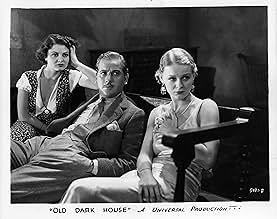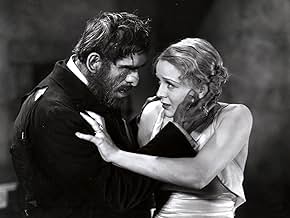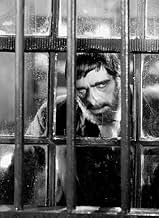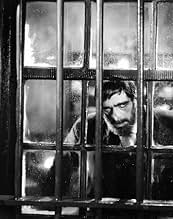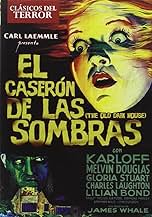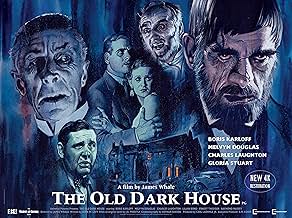NOTE IMDb
7,0/10
14 k
MA NOTE
Cherchant refuge pendant un orage, cinq voyageurs sont bons pour une nuit bizarre et terrifiante lorsqu'ils tombent sur le domaine familial des Femm.Cherchant refuge pendant un orage, cinq voyageurs sont bons pour une nuit bizarre et terrifiante lorsqu'ils tombent sur le domaine familial des Femm.Cherchant refuge pendant un orage, cinq voyageurs sont bons pour une nuit bizarre et terrifiante lorsqu'ils tombent sur le domaine familial des Femm.
- Réalisation
- Scénario
- Casting principal
- Récompenses
- 1 nomination au total
Avis à la une
Tales about sinister, creepy mansions were already clichéd by the time director James Whale directed THE OLD DARK HOUSE--and instead of presenting the piece as a straight-forward thriller he mixed the film's very atmospheric cinematography with a wild strain of parody. The result is a movie with a bizarre camp humor that foreshadows Whale's slightly later and even more bizarrely camp THE BRIDE OF FRANKESTEIN.
The plot, very based loosely on a J.B. Priestly novel, is perfunctory, existing only to throw together an ensemble cast of already-famous and soon-to-be-famous stars. Five motorists are trapped in the wilds of Wales during a horrific storm and are forced to seek shelter at, of course, an old dark house... but their unwilling hosts are a neurotic Ernest Thesiger, his religious fanatic sister Eva Moore, and their hulking, deformed, and mute butler Boris Karloff. Before the night is over the storm-weary travelers experience everything from a hellish meal to religious lectures--not to mention assault, attempted rape, mysterious cackling, a bit of arson, and a touch of homosexual hysteria (courtesy of Thesiger, Moore, and a surprise male character who is actually played by a woman) thrown in for good measure.
The cast is exceptional; in addition to Karloff, Thesiger, and Moore, we have Melvyn Douglas, Raymond Massey, Charles Laughton, Gloria Stuart, and Lilian Bond, and they wring the most from the covertly wicked script, with Eva Moore ranting about "laughter and sin," Thesiger inviting Raymond Massey into his room "to see a few things," and one of the most socially awkward meals ever put to film. But the film's real power is its cinematography: when they say old DARK house, they really mean it, and the look of the film is just as disorienting for viewers as for the characters; particularly noteworthy is the scene in which Moore lectures Gloria Stuart, with their faces distorted by the bedroom mirror, and the sequence in which Karloff pursues the white-clad and wind-whipped Gloria Stuart with mayhem in mind.
Viewers who expect "Universial Horror" fare will probably be disappointed by THE OLD DARK HOUSE, and director James Whale would create a still more memorable combination of horror and high-camp with THE BRIDE OF FRANKENSTIEN. But THE OLD DARK HOUSE is an overlooked jewel of unusual quality: a sardonic parody of a famous theme, well played, filmed and scripted. Recommended.
Gary F. Taylor, aka GFT, Amazon Reviewer
The plot, very based loosely on a J.B. Priestly novel, is perfunctory, existing only to throw together an ensemble cast of already-famous and soon-to-be-famous stars. Five motorists are trapped in the wilds of Wales during a horrific storm and are forced to seek shelter at, of course, an old dark house... but their unwilling hosts are a neurotic Ernest Thesiger, his religious fanatic sister Eva Moore, and their hulking, deformed, and mute butler Boris Karloff. Before the night is over the storm-weary travelers experience everything from a hellish meal to religious lectures--not to mention assault, attempted rape, mysterious cackling, a bit of arson, and a touch of homosexual hysteria (courtesy of Thesiger, Moore, and a surprise male character who is actually played by a woman) thrown in for good measure.
The cast is exceptional; in addition to Karloff, Thesiger, and Moore, we have Melvyn Douglas, Raymond Massey, Charles Laughton, Gloria Stuart, and Lilian Bond, and they wring the most from the covertly wicked script, with Eva Moore ranting about "laughter and sin," Thesiger inviting Raymond Massey into his room "to see a few things," and one of the most socially awkward meals ever put to film. But the film's real power is its cinematography: when they say old DARK house, they really mean it, and the look of the film is just as disorienting for viewers as for the characters; particularly noteworthy is the scene in which Moore lectures Gloria Stuart, with their faces distorted by the bedroom mirror, and the sequence in which Karloff pursues the white-clad and wind-whipped Gloria Stuart with mayhem in mind.
Viewers who expect "Universial Horror" fare will probably be disappointed by THE OLD DARK HOUSE, and director James Whale would create a still more memorable combination of horror and high-camp with THE BRIDE OF FRANKENSTIEN. But THE OLD DARK HOUSE is an overlooked jewel of unusual quality: a sardonic parody of a famous theme, well played, filmed and scripted. Recommended.
Gary F. Taylor, aka GFT, Amazon Reviewer
Seeking shelter from a storm, five travelers are in for a bizarre and terrifying night when they stumble upon the Femm family estate.
The film is based on the novel "Benighted" (1927) by J. B. Priestley, who saw the "queer inmates" of the house as symbols of post-war pessimism. He was quite reluctant to sell the rights, thinking his characters would not adapt well to the screen. However, in January 1932, he changed his mind when Universal offered him $12,500 (roughly $215,000 in 2017 money).
The novel was adapted for the screen by R. C. Sheriff ("The Invisible Man") and Benn Levy (Hitchcock's "Blackmail"). Universal Studios producer Carl Laemmle invited Levy from England to Universal City after being impressed with Levy's screenplay for "Waterloo Bridge" (1931), which was also directed by James Whale. Sheriff and Levy were able to have a script fleshed out by March 1932, a mere two months.
James Whale worked with many collaborators from his previous films including Arthur Edeson, who was the cinematographer for "Frankenstein" (1931) and "Waterloo Bridge" (1931) and set designer Charles D. Hall, who also worked on "Frankenstein". Edeson went on to help create the American Society of Cinematographers (ASC) and become its president. Hall kept "Old Dark House" very scaled back; a viewer could easily mistake the film for a stage production. Ultimately, Hall would work on 11 of Whale's 20 films.
For genre fans, the most obvious repeat collaborator is Boris Karloff, who plays the supporting role of a mute butler. Interestingly, though Karloff's best-known role is Frankenstein's Monster (under Whale's direction), and Whale's best-known film (also "Frankenstein") starred Karloff, the two were not necessarily friends. Cordial, yes, but never close, and yet their names are linked for all eternity.
The cast is all-star by anyone's standards. Whale chose newcomer Gloria Stuart for the glamour role, and this lead to her wider success and her helping found the Screen Actors Guild (SAG). She would soon work with Whale again on both "The Kiss Before the Mirror" and "The Invisible Man", both released in 1933. This was Charles Laughton's first Hollywood film, which came shortly after Laughton had worked with Whale on the English stage.
Laughton was married to Elsa Lanchester, who played the title role in Whale's "Bride of Frankenstein" (1935). "Old Dark House" also started Ernest Thesiger's Hollywood career, and he would go on to work on Whale's "Bride" as Dr. Septimus Pretorius, a role that the studio wanted Claude Rains to have. Of course, Thesiger embodies that role and is as memorable as the bride herself. At the time of casting "Old Dark House", Thesiger had already known Whale and was appearing in one of Benn Levy's plays.
According to Stuart, Whale was a very hands-on director, deciding line delivery, walking, costumes and more. She saw him as an "artist" with his background in both acting and set design, and was "fussy" about makeup, jewelry and props. Because of his rapport with Thesiger, Whale allowed for the most deviations from the script (and book) for his old friend.
"The Old Dark House" was largely ignored at the American box office, although it was a huge hit in Whale's native England. Variety and the Hollywood Filmograph gave the film negative reviews, with Variety calling it a "somewhat inane picture". Other reviews were more positive, but on the whole it was not seen as an instant classic, much to the astonishment of modern audiences.
For many years, the original version was considered a lost film and gained a tremendous reputation as one of the pre-eminent Gothic horror films. Whale's fellow director and friend Curtis Harrington ("Night Tide") helped to prevent "The Old Dark House" from becoming a lost film. Harrington met Whale and Whale's partner David Lewis in 1948, at a time when (according to Harrington) "Whale had no critical reputation at all", unlike how film historians view him today.
When Harrington was signed to Universal in 1967 to direct "Games" with James Caan, he repeatedly asked Universal to locate the film negative of "Old Dark House", although it was Harrington himself who discovered a print of the film in the vaults of Universal Studios in 1968. He persuaded James Card the George Eastman House film archive to finance a new duplicate negative of the poorly-kept first reel, and restore the rest of the film. The original nitrate negative had survived, though the first reel only existed as a lavender protection print.
Harrington further was the one responsible for getting the film legally released. Because Universal had not pursued the copyright, the rights to the story reverted to the Priestley estate and were bought up by Columbia, who released an inferior remake by acclaimed director William Castle in 1963. Harrington was able to convince Columbia to allow copies of the Universal film to be made, though it would be years before distribution and re-screenings were legally cleared.
In 2017, the Cohen Film Collection released a brand new Blu-ray featuring a 4K restoration that brings this classic back to life. They also packed the disc with two different commentaries (one with actress Gloria Stuart, the other with James Whale biographer James Curtis). There is a featurette on how Curtis Harrington saved the film from obscurity, and a completely new 15-minute interview with Sara Karloff.
The film is based on the novel "Benighted" (1927) by J. B. Priestley, who saw the "queer inmates" of the house as symbols of post-war pessimism. He was quite reluctant to sell the rights, thinking his characters would not adapt well to the screen. However, in January 1932, he changed his mind when Universal offered him $12,500 (roughly $215,000 in 2017 money).
The novel was adapted for the screen by R. C. Sheriff ("The Invisible Man") and Benn Levy (Hitchcock's "Blackmail"). Universal Studios producer Carl Laemmle invited Levy from England to Universal City after being impressed with Levy's screenplay for "Waterloo Bridge" (1931), which was also directed by James Whale. Sheriff and Levy were able to have a script fleshed out by March 1932, a mere two months.
James Whale worked with many collaborators from his previous films including Arthur Edeson, who was the cinematographer for "Frankenstein" (1931) and "Waterloo Bridge" (1931) and set designer Charles D. Hall, who also worked on "Frankenstein". Edeson went on to help create the American Society of Cinematographers (ASC) and become its president. Hall kept "Old Dark House" very scaled back; a viewer could easily mistake the film for a stage production. Ultimately, Hall would work on 11 of Whale's 20 films.
For genre fans, the most obvious repeat collaborator is Boris Karloff, who plays the supporting role of a mute butler. Interestingly, though Karloff's best-known role is Frankenstein's Monster (under Whale's direction), and Whale's best-known film (also "Frankenstein") starred Karloff, the two were not necessarily friends. Cordial, yes, but never close, and yet their names are linked for all eternity.
The cast is all-star by anyone's standards. Whale chose newcomer Gloria Stuart for the glamour role, and this lead to her wider success and her helping found the Screen Actors Guild (SAG). She would soon work with Whale again on both "The Kiss Before the Mirror" and "The Invisible Man", both released in 1933. This was Charles Laughton's first Hollywood film, which came shortly after Laughton had worked with Whale on the English stage.
Laughton was married to Elsa Lanchester, who played the title role in Whale's "Bride of Frankenstein" (1935). "Old Dark House" also started Ernest Thesiger's Hollywood career, and he would go on to work on Whale's "Bride" as Dr. Septimus Pretorius, a role that the studio wanted Claude Rains to have. Of course, Thesiger embodies that role and is as memorable as the bride herself. At the time of casting "Old Dark House", Thesiger had already known Whale and was appearing in one of Benn Levy's plays.
According to Stuart, Whale was a very hands-on director, deciding line delivery, walking, costumes and more. She saw him as an "artist" with his background in both acting and set design, and was "fussy" about makeup, jewelry and props. Because of his rapport with Thesiger, Whale allowed for the most deviations from the script (and book) for his old friend.
"The Old Dark House" was largely ignored at the American box office, although it was a huge hit in Whale's native England. Variety and the Hollywood Filmograph gave the film negative reviews, with Variety calling it a "somewhat inane picture". Other reviews were more positive, but on the whole it was not seen as an instant classic, much to the astonishment of modern audiences.
For many years, the original version was considered a lost film and gained a tremendous reputation as one of the pre-eminent Gothic horror films. Whale's fellow director and friend Curtis Harrington ("Night Tide") helped to prevent "The Old Dark House" from becoming a lost film. Harrington met Whale and Whale's partner David Lewis in 1948, at a time when (according to Harrington) "Whale had no critical reputation at all", unlike how film historians view him today.
When Harrington was signed to Universal in 1967 to direct "Games" with James Caan, he repeatedly asked Universal to locate the film negative of "Old Dark House", although it was Harrington himself who discovered a print of the film in the vaults of Universal Studios in 1968. He persuaded James Card the George Eastman House film archive to finance a new duplicate negative of the poorly-kept first reel, and restore the rest of the film. The original nitrate negative had survived, though the first reel only existed as a lavender protection print.
Harrington further was the one responsible for getting the film legally released. Because Universal had not pursued the copyright, the rights to the story reverted to the Priestley estate and were bought up by Columbia, who released an inferior remake by acclaimed director William Castle in 1963. Harrington was able to convince Columbia to allow copies of the Universal film to be made, though it would be years before distribution and re-screenings were legally cleared.
In 2017, the Cohen Film Collection released a brand new Blu-ray featuring a 4K restoration that brings this classic back to life. They also packed the disc with two different commentaries (one with actress Gloria Stuart, the other with James Whale biographer James Curtis). There is a featurette on how Curtis Harrington saved the film from obscurity, and a completely new 15-minute interview with Sara Karloff.
First one carload of normal people who can't go on due to flash flooding stop in a Gothic horror house for food and shelter and then another. Strange doings are happening at the house occupied by the Femm family and their mute servant Morgan.
You can't really say there is any kind of coherent plot to the unfolding events and plot for me is usually the one indispensable part of any film. But in this case I make an exception because obviously Director James Whale was having a little fun with the audience by now used to Universal Studios horror film products. Whale creates a film of dark moods and light banter among the guests who can't quite figure out what's with this family of weirdos.
The Old Dark House marked the American film debut of Charles Laughton and Laughton overacts outrageously as does the whole cast in the role a bluff, overbearing, but essentially good hearted Manchester businessman who's got himself a Sir before his name and is right proud of it. This was also early work for Melvyn Douglas and Raymond Massey as another two of the guests.
Boris Karloff plays the sinister and mute servant Morgan. Karloff had one of the great speaking voices ever in films and interesting that this and his break through role as the Frankenstein monster required no dialog.
The Old Dark House is one great Halloween movie and listen close to the campy dialog that will tickle your funny bone if you don't miss it.
You can't really say there is any kind of coherent plot to the unfolding events and plot for me is usually the one indispensable part of any film. But in this case I make an exception because obviously Director James Whale was having a little fun with the audience by now used to Universal Studios horror film products. Whale creates a film of dark moods and light banter among the guests who can't quite figure out what's with this family of weirdos.
The Old Dark House marked the American film debut of Charles Laughton and Laughton overacts outrageously as does the whole cast in the role a bluff, overbearing, but essentially good hearted Manchester businessman who's got himself a Sir before his name and is right proud of it. This was also early work for Melvyn Douglas and Raymond Massey as another two of the guests.
Boris Karloff plays the sinister and mute servant Morgan. Karloff had one of the great speaking voices ever in films and interesting that this and his break through role as the Frankenstein monster required no dialog.
The Old Dark House is one great Halloween movie and listen close to the campy dialog that will tickle your funny bone if you don't miss it.
Director James Whale and his cast probably had a good time making this film. After the opening credits there's a "producer's note": 'Karloff, the mad butler in this production, is the same Karloff who created the part of the mechanical monster in "Frankenstein". We explain this to settle all disputes in advance, even though such disputes are a tribute to his great versatility.'
So you're know what you're in for, at least modern audiences should. Back then it must have been quite daring to openly "expose" and perhaps even undermine the potential scariness of the film, especially Karloff's role as the butler. I think many executives at Universal frowned upon this as well, in particular Carl Laemmle Sr., but Carl Laemmle Jr. probably shared the same kind of humor as Whale, so they let him get away with it.
The film is very loyal to J.B. Priestley's novel "Benighted" and took most of the wonderful dialogs and one-liners directly from the book. As one would expect from James Whale en co, the sharply written dialog is definitely one of the highlights with the best lines being handed to Thesiger, as in THE BRIDE OF FRANKENSTEIN. This supposedly being a send-up of Universal's horror conventions, it's not particularly engaging as a horror film. Eerie things do happen, absolutely, but they are so bizarre and sometimes so utterly over the top, that you either stop caring about the characters or simply lose track of the proceedings at all. But no complaints about the acting, especially the incomparable Ernest Thesiger who is a standout in a first rate cast. And the sets and photography are absolutely superb as is the whole atmosphere in general, largely due to the continuously (and well timed) stormy soundtrack, which greatly adds to the fun.
Many have pointed out that Whale presents us some kind of parody of the horror movie or some kind of archetypal English household. This seems a very modern, almost anachronistic vision to me. What things did he attempt to mock or make fun of? Essentially THE OLD DARK HOUSE is a well acted sometimes very funny stagy farce with a horror atmosphere at best. He certainly had the last laugh because he probably never intended it that way, although most of the critical acclaim came after his death.
A final note on the Special Collector's Edition DVD: Besides the obligatory stills gallery, nothing of particular interest. A six-minute interview with Curtis Harrington about him saving the original copy of the film. Good thing he did it but that's all we need to know. And truly worthless commentary tracks, James Curtis comments like he's reading a list with all kinds of facts about the movie. Suitable for a booklet, not for an audio commentary.
Camera Obscura --- 8/10
So you're know what you're in for, at least modern audiences should. Back then it must have been quite daring to openly "expose" and perhaps even undermine the potential scariness of the film, especially Karloff's role as the butler. I think many executives at Universal frowned upon this as well, in particular Carl Laemmle Sr., but Carl Laemmle Jr. probably shared the same kind of humor as Whale, so they let him get away with it.
The film is very loyal to J.B. Priestley's novel "Benighted" and took most of the wonderful dialogs and one-liners directly from the book. As one would expect from James Whale en co, the sharply written dialog is definitely one of the highlights with the best lines being handed to Thesiger, as in THE BRIDE OF FRANKENSTEIN. This supposedly being a send-up of Universal's horror conventions, it's not particularly engaging as a horror film. Eerie things do happen, absolutely, but they are so bizarre and sometimes so utterly over the top, that you either stop caring about the characters or simply lose track of the proceedings at all. But no complaints about the acting, especially the incomparable Ernest Thesiger who is a standout in a first rate cast. And the sets and photography are absolutely superb as is the whole atmosphere in general, largely due to the continuously (and well timed) stormy soundtrack, which greatly adds to the fun.
Many have pointed out that Whale presents us some kind of parody of the horror movie or some kind of archetypal English household. This seems a very modern, almost anachronistic vision to me. What things did he attempt to mock or make fun of? Essentially THE OLD DARK HOUSE is a well acted sometimes very funny stagy farce with a horror atmosphere at best. He certainly had the last laugh because he probably never intended it that way, although most of the critical acclaim came after his death.
A final note on the Special Collector's Edition DVD: Besides the obligatory stills gallery, nothing of particular interest. A six-minute interview with Curtis Harrington about him saving the original copy of the film. Good thing he did it but that's all we need to know. And truly worthless commentary tracks, James Curtis comments like he's reading a list with all kinds of facts about the movie. Suitable for a booklet, not for an audio commentary.
Camera Obscura --- 8/10
It's one of director James Whale's most offbeat films along with "Bride of Frankenstein" (IMHO his masterpiece). It's based on the J.B. Priestley novel and it was filmed during the Pre-Code Era. I'd say it's a mixture of horror film, spoof and black comedy...in some aspects it's related to "Arsenic and Old Lace", although it has a darker mood.
On a very stormy night, a group of travelers find shelter in an eerie and scary welsh manor, inhabited by the "weird" Femm family, and there begins a quick chain of events (the film lasts only 72 minutes) until the film's conclusion. The weary and wet travelers include Raymond Massey and Gloria Stuart as a married couple who are traveling through the country with happy-go-lucky friend Mr. Penderel, played by Melvyn Douglas. Other travelers who arrive to this Huge House, are Charles Laughton, playing a rich businessman of humble origins with his lover, Lillian Bond, who's great and very sexy in her role of a joyous chorus-girl.
Then we have the Femms: Religion fanatic Rebecca Femm, who has an obsession with "sinners", expertly played by sinister-looking Eva Moore; her wishy-washy brother Horace Femm, played by the great Ernest Thesiger, who impersonated "Dr. Pretorius" in "Bride of Frankenstein"; 102 years old Sir Roderick Femm, who is played by actress Elspeth Dudgeon, who's listed in the cast as "John" Dudgeon (creepy character!) and "seemingly harmless" psychopath and pyromaniac Saul Femm, played by Brember Wills.
Boris Karloff deserves to be mentioned apart, who impersonates the scarred butler, Morgan, who lusts after Mrs. Waverton (Gloria Stuart), perhaps because she gets to wear a sexy 1930s low-cut dress, the type which pre-Code Jean Harlow wore.
Whale's direction is excellent. I was especially impressed with the shot of the front of the spooky old house in which the Femms reside as seen from the eyes of the passengers in the car. Whale liked to use a subjective camera, which was unusual for many early thirties movies. The camera is the viewer as that viewer moves through the scenes.
Best of all was the late Gloria Stuart's commentary on the Kino DVD, which was excellent. She is such a pleasure to listen to as she reminisces about the movie, and talks all about everyone involved. I never would've known anything about the brilliant actress Eva Moore if it wasn't for her great commentary. She provides so much insight, and is so funny and charming at the same time. She also talks about other things, and other aspects of her career. It's almost like having a conversation with her, she's that relaxed. She speaks very highly of James Whale, and says that he's the best director she ever worked with. She points out different aspects of his filming, especially his use of shadows. She says that making this movie was the high point of her career, and that she never made another movie that she enjoyed working on as much as this one. Take that James Cameron!
Highly recommended.
On a very stormy night, a group of travelers find shelter in an eerie and scary welsh manor, inhabited by the "weird" Femm family, and there begins a quick chain of events (the film lasts only 72 minutes) until the film's conclusion. The weary and wet travelers include Raymond Massey and Gloria Stuart as a married couple who are traveling through the country with happy-go-lucky friend Mr. Penderel, played by Melvyn Douglas. Other travelers who arrive to this Huge House, are Charles Laughton, playing a rich businessman of humble origins with his lover, Lillian Bond, who's great and very sexy in her role of a joyous chorus-girl.
Then we have the Femms: Religion fanatic Rebecca Femm, who has an obsession with "sinners", expertly played by sinister-looking Eva Moore; her wishy-washy brother Horace Femm, played by the great Ernest Thesiger, who impersonated "Dr. Pretorius" in "Bride of Frankenstein"; 102 years old Sir Roderick Femm, who is played by actress Elspeth Dudgeon, who's listed in the cast as "John" Dudgeon (creepy character!) and "seemingly harmless" psychopath and pyromaniac Saul Femm, played by Brember Wills.
Boris Karloff deserves to be mentioned apart, who impersonates the scarred butler, Morgan, who lusts after Mrs. Waverton (Gloria Stuart), perhaps because she gets to wear a sexy 1930s low-cut dress, the type which pre-Code Jean Harlow wore.
Whale's direction is excellent. I was especially impressed with the shot of the front of the spooky old house in which the Femms reside as seen from the eyes of the passengers in the car. Whale liked to use a subjective camera, which was unusual for many early thirties movies. The camera is the viewer as that viewer moves through the scenes.
Best of all was the late Gloria Stuart's commentary on the Kino DVD, which was excellent. She is such a pleasure to listen to as she reminisces about the movie, and talks all about everyone involved. I never would've known anything about the brilliant actress Eva Moore if it wasn't for her great commentary. She provides so much insight, and is so funny and charming at the same time. She also talks about other things, and other aspects of her career. It's almost like having a conversation with her, she's that relaxed. She speaks very highly of James Whale, and says that he's the best director she ever worked with. She points out different aspects of his filming, especially his use of shadows. She says that making this movie was the high point of her career, and that she never made another movie that she enjoyed working on as much as this one. Take that James Cameron!
Highly recommended.
Le saviez-vous
- AnecdotesThis was Boris Karloff's first credited starring role. His name had been left off the Frankenstein (1931) publicity packages and only credited in the end credits of that film.
- GaffesOne of Gloria Stuart's elaborate earrings is missing about mid-film, it reappears for 2 close up shots and disappears again in medium and long shots.
- Citations
Rebecca Femm: [feels the fabric of Margaret Waverton's low-cut gown] Fine stuff, but it'll rot.
Rebecca Femm: [touches Margaret's skin above the neckline] Finer stuff still, but it'll rot too!
- Crédits fousBefore the Universal Pictures logo: PRODUCER'S NOTE: - Karloff, the mad butler in this production, is the same Karloff who created the part of the mechanical monster in "Frankenstein". We explain this to settle all disputes in advance, even though such disputes are a tribute to his great versatility
- ConnexionsEdited into Pale Moonlight Theater: The Old Dark House (2015)
- Bandes originalesSingin' in the Rain
(uncredited)
Music by Nacio Herb Brown
Lyrics by Arthur Freed
Sung by Melvyn Douglas a cappella, with modified lyrics
[Penderel sings the song in the car as the he and the Wavertons make their way on the washed out road]
Meilleurs choix
Connectez-vous pour évaluer et suivre la liste de favoris afin de recevoir des recommandations personnalisées
Détails
- Date de sortie
- Pays d’origine
- Langue
- Aussi connu sous le nom de
- L'appel de la chair
- Lieux de tournage
- Société de production
- Voir plus de crédits d'entreprise sur IMDbPro
Box-office
- Montant brut aux États-Unis et au Canada
- 25 678 $US
- Montant brut mondial
- 34 649 $US
- Durée
- 1h 12min(72 min)
- Couleur
- Rapport de forme
- 1.37 : 1
Contribuer à cette page
Suggérer une modification ou ajouter du contenu manquant



